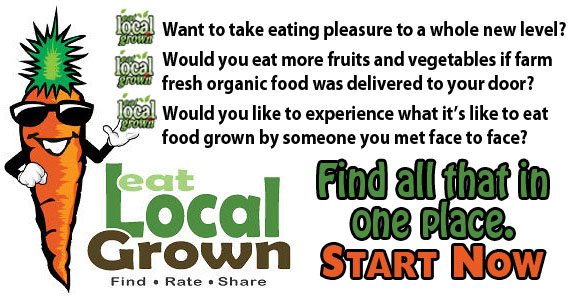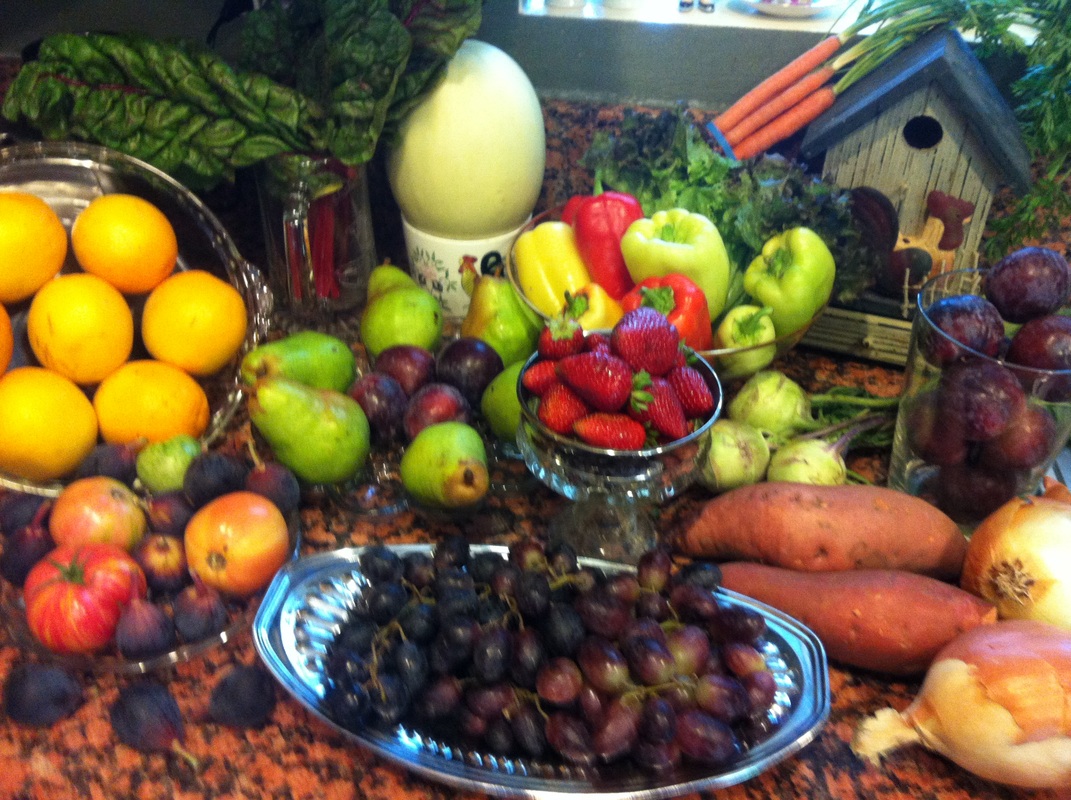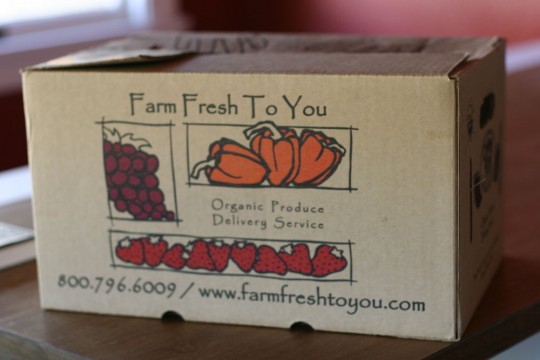
Author Lisa Leak and Elaine McFadden, MPH, RD
We thought the 14 Steps that Lisa Leak put together where great and might be the perfect road map for someone looking for one new eating, cooking, or shopping skill they could try and practice and incorporate into their daily routine that could make a big difference in helping to eliminate the kind of foods that could contribute to chronic disease or obesity. Master any or all of the skills below and you will see major changes in your body and energy level. With all the money you will save on fast food, high priced beverages, and more food than you really need, you can instead buy high quality real foods that you prepare into easy, simple meals that have more flavor, and even store longer to save money on spoilage.
Try and add one new "food skill" per week and practice it each day.
Lisa's original recommendations in black and Smart Health Talk comments in red.
Week 1: Two fruits and/or vegetables per meal– Eat a minimum of two different fruits or vegetables (preferably organic) with every breakfast, lunch, and dinner meal. Fruits can have twice the calories as vegetables so always great when vegetables are the top choice and save fruit for when you get a strong craving for sweets. Add more vegetables to meals that you already make. For example even if you went for a can of Amy's Spicy Organic Chili, you could pump it up by adding onions, tomatoes, bell pepper, corn, and even another can of beans which is much cheaper than the chili and increases the volume 3X. You can even find canned organic beans at the 99 cent store. With vegetables at 25 calories a half cup, you can eat more and feel satisfied.
Week 2: “Real” beverages – Beverages will be limited to coffee, tea, water, and milk (only naturally sweetened with a little honey or 100% pure maple syrup). One cup of juice will be allowed throughout the week, and wine (preferably red) will be allowed in moderation (an average of one drink per day).
Milk can have GMOs and raised using industrial inhumane conditions, so buy organic. Consider using raw milk for the highest quality of nutrition and to prevent and even heal from allergies.
Week 3: Meat – All meat consumed this week will be locally raised (within 100-miles of your hometown). Meat consumption will also be limited to 3 – 4 servings this week, and when it is eaten meat will not be presented as the “focal point” of the meal. Instead meat will be treated as a side item or simply used to help flavor a dish. Conventional meat grown on industrial farms is fed GMOs, expired junk food, chicken feathers, daily doses of antibiotics, and treated inhumanely. Grassfed beef is allowed to roam, is far superior and contains Omega 3s and CLA a special fatty acid that is good for your heart and controlling inflammation. It can also help protect you from cancer, control blood pressure and blood sugar. Non organic chickens are not only fed antibiotics daily but arsenic too. The chickens live in terrible conditions with the antibiotics helping fatten them up in a short unnatural amount of time just like they fatten us up too. Conventional processed meats are full of cancer causing nitrates. Don't buy processed meats and NEVER buy farmed salmon. Dirty operations that are destroying entire eco systems. Farmed fish sold in stores has been diagnosed with viruses that have spread to wild salmon and are responsible for killing millions of wild salmon before they can even spawn. Genetically engineered salmon gives you a double whammy of being infected with viruses, cross bred with an eel, three times as big and turns into a cannibal when food is low and will eat another wild salmon. Will eat all the food and wipe out our wild populations and when gets out (they do everyday) will cross contaminate other fish and can never take it back.
Week 4: No fast food or deep-fried foods – No fast food or any foods that have been deep-fried in oil. The oil used for cooking fast food is probably GMO and rancid which is cancer causing. Fat is 100 calories a tablespoon and vegetables only 25 calories for a half cup. Eat baked not fried.
Week 5: Try two new whole foods – Try a minimum of two new whole foods that you’ve never had before. This "exploration exercise" can be fun and a chance to get the kids involved. Let them help pick the new food to try, figure out what recipe to use to cook it, and then help prepare. Chances are after they have helped with all of that they will eat it. Try a theme night to highlight your new food such as picking a country, a food from that country, and can decorate and even dress up to go with the theme. Use EatLocalGrown.com to find a farmers market in your area and go looking for something new and exciting to try from the market. Many times the farmer can give you some preparation ideas or go and visit us on Pinterest and find some great weight loss, vegan, raw, or paleo recipe choices.
Week 6: No low-fat, lite or nonfat food products – Do not eat any food products that are labeled as “low-fat,” “lite,” “light,” “reduced fat,” or “nonfat.” Never buy these types of products because when they take the fat out they have to replace it with something and it is probably sugar or something manmade or worse such as transfats which are fats that have been modified to stay a solid at room temperature even though they don't start off as a solid. When you see "artificial flavor" on the label it could be hiding another 50 chemicals that it took to make that fake flavor.
Week 7: 100% Whole grain – All grains consumed must be 100% whole-grain. Agree you should always choose whole grain, but would like to add to be very careful about the grains and how much you are eating. Have to recommend that you stay away from wheat as much as possible. The wheat has been so altered that our bodies don't even recognize the protein anymore. Only organic sprouted wheat and try and keep that intake low. Only eat organic brown rice if possible. Also oats, buckwheat, quinoa, and Salba Chia which is our #1 top pick as a grain. The Salba chia expands sixteen times it 's size and has super fiber and a slew of nutrients and Omega 3s. If you add it to any carbohydrate food it will keeps blood sugar from spiking.
Week 8: Stop eating when you feel full – Listen to your internal cues and stop eating when you feel full. Have to add to that to not eat if you are not hungry either. Some people do well with several small meals throughout the day, but others may do better with just one meal that has some from all groups with a focus on vegetables and a good quality protein and maybe just some almonds or Salba Chia mixed in water. Organic eggs are the best protein bargain in the store, or better yet buy them right from a local organic farmer. See what the eggs we get each week look like below. Think about stopping before you are full, say about 80% full to keep from feeling miserable a little while later.
Week 9: No refined sweeteners – No refined or artificial sweeteners including (but not limited to): white sugar, brown sugar, raw sugar, sucanat, splenda, stevia, agave, corn syrup, high-fructose corn syrup, brown rice syrup, and cane juice. Foods and beverages can only be sweetened with a moderate amount of honey or maple syrup. Organic raw honey is the gold standard when it comes to sweetener. Don't buy regular, filtered honey. Why? All the good stuff is gone. Most all corn based sweeteners and artificial sweeteners are GMO. Don't use them EVER. Organic maple syrup has special nutritional value as well. Remember that honey/syrup is 100 calories a tablespoon. Can add up quick.
Week 10: No refined oils – No refined or hydrogenated oils including (but not limited to): vegetable oil, organic vegetable oil, soybean oil, corn oil, canola oil, organic canola oil, margarine, and grape seed oil. NEVER BUY OR EAT HYDROGENATED OILS. Don't depend on "Nutrition Facts" to tell you if there are transfats in the product. If 0.5 grams or less they don't have to list, but if you look at ingredients and see "hydrogenated" oil, you will know that there are transfats. Any soybean, canola, or corn oil is GMO SO DON'T EVER BUY IT UNLESS ORGANIC. Personally never buy margarine. Organic grassfed butter, organic olive oil, grapeseed oil, sesame, and peanut oils are our top choices.
Week 11: Eat local foods – Eat at least 1 locally grown or raised food at each meal. This includes, but is not limited to: fruits, vegetables, eggs, grains, nuts, meats, and sweeteners like honey. Use EatLocalGrown.com and find a farmer's market or CSA (Community Sustainable Agriculture) that is a local farmer and grows weekly shares of food for local families. You get a box of organic food fresh picked each week. Sometimes they will deliver to your door. Could be a local farmer or big organic home delivery operation like Farm Fresh to You. Recommend both. Like your birthday each week with a special surprise on what you will get.
Week 12: No sweeteners – Avoid all added sweeteners including, but not limited to: white sugar, brown sugar, raw sugar, honey, maple syrup, date sugar, maple sugar, sucanat, splenda, stevia, agave, fruit juice concentrate, corn syrup, high-fructose corn syrup, brown rice syrup, and cane juice. This is taking it one step further with sugar. You should eliminate anything with high frutose corn syrup, and try living without sugar even for just one day. Have gotten it down to just my cup of coffee in the morning and with my tea. Most all other foods don't have added sugar.
Week 13: Nothing artificial – Avoid all artificial ingredients including, but not limited to: sweeteners, flavors and colors. The government has approved over 80,000 chemicals to be used in foods. Some were never tested for safety and were introduced before testing. They were allowed because they had been used for awhile and didn't seem like they were causing any harm so we really don't know about those because there never was scientific testing. Other chemicals that have been approved are all based on what the manufacturer reports, the government does not test products for safety, but just accepts the word of the company making it. The maker may be able to test the chemical in a way that makes it look safe, but we don't really know about the interaction between chemicals in our body, and as we mentioned earlier when you see "artificial flavor" it can be hiding 50+ chemicals needed to make a fake flavor. Those 50 chemicals you will never have heard of before, maybe not even if you are a chemist. Many artificial flavors are recommended to NEVER EAT OR EAT WITH CAUTION.
Why risk it?
Week 14: No more than 5-ingredients – Avoid any and all packaged food products that contain more than five ingredients no matter what ingredients. Try and choose products with organic, whole food ingredients for the most nutrition bang for your buck.
Know Where Your Food Comes From Whenever possible, please support local growers by shopping at a farmers market! Getting to know the people that actually grow your food is a great experience and you'll be supporting your local community at the same time.








 RSS Feed
RSS Feed
